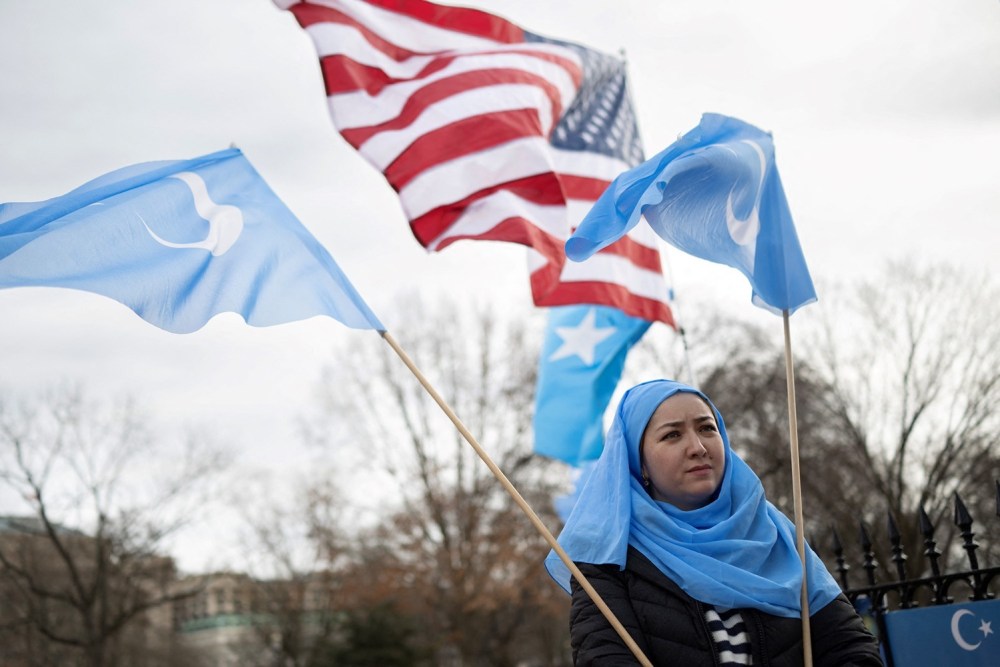People hold up flags and signs during a protest in Washington, D.C., marking the 26th anniversary of the 1997 Ghulja massacre in Ghulja, in the Xinjiang province of China, on Feb. 5. ANDREW CABALLERO-REYNOLDS/AFP VIA GETTY IMAGES
For years, American consumers unwittingly bought products from T-shirts to solar panels sourced from Xinjiang, where researchers have found that the Chinese government has used a vast forced labor system to control the Uyghur population.
Last June, a new U.S. law went into effect aimed at ending the flow of goods from Xinjiang to the states—and ending the forced labor system behind it. Under the Uyghur Forced Labor Prevention Act (UFLPA), which passed with bipartisan support, all goods produced fully or partly in Xinjiang are presumed to have been made under coercion and therefore barred from entry into the U.S., unless a company can prove otherwise. When it was passed, the law was heralded as the U.S. government’s strongest step yet to address human rights abuses in Xinjiang.
Now, more than a year since the law went into effect, a recent report suggests that it has had mixed success. The report, authored by researchers at Sheffield Hallam University, focuses on China’s solar industry—one of the law’s key targets.
For the solar business, U.S. scrutiny began even before the law was passed. In 2021, the United States started blocking solar imports linked to a major upstream supplier based in Xinjiang. It was a warning shot—one that Chinese solar manufacturing giants heeded. They forged new supply chains for the U.S. market, inking supply deals for a critical ingredient of solar panel production, polysilicon, with U.S.- and Germany-based companies to avoid Xinjiang sources.
Trade data shows that these shifts have added up. As of 2020, Xinjiang accounted for about 45 percent of the global solar-grade polysilicon supply; by 2022, the share had dropped to 35 percent, according to the solar industry analysis firm Bernreuter Research.
Despite these efforts to create Xinjiang-free supply chains, under the new law, U.S. Customs and Border Protection has taken a cautious approach—detaining shipments from the big Chinese solar companies based on their historical links to Xinjiang. Since last June, when the law went into effect, the agency has detained more than 4,650 shipments at U.S. ports, and the solar industry has been the most affected, said Richard Mojica, a lawyer at Miller & Chevalier who works with companies on UFLPA compliance.
The initial spike in detained solar shipments raised concerns in the renewable energy industry about the extent of the delays and disruption. However, after those early months of turbulence, the law appears to be reducing the flow of Xinjiang-made goods without significantly delaying other solar imports. Solar companies now have the supply chain documentation to clear impounded shipments quickly, as long at their polysilicon comes from outside of China, Mojica said. The process initially took months; now it only takes a matter of weeks, he added.
That’s a relief for those renewable energy companies. “While the detainments may slow down a few projects here and there, it’s not going to be a major structural issue for the market this year,” said Pol Lezcano, a senior associate at Bloomberg New Energy Finance. Even as the U.S. ramps up its installation of solar power to meet its climate goals, the law isn’t expected to pose a significant hurdle, he added; there is now enough polysilicon produced outside of China to meet U.S. demand in the coming years.
Human rights advocates have praised the progress under the UFLPA, while cautioning that the screening process isn’t 100 percent effective. “If we’re consumers buying a solar panel, I don’t think we can be completely confident that it’s not made with Uyghur forced labor, but I can say that we can be a lot more confident” than before the law, said Laura Murphy, a professor of human rights at Sheffield Hallam University and co-author of the report.
In other sectors targeted by U.S. customs agents, such as apparel and agriculture, companies are also now responsible for tracing their full supply chains and avoiding Xinjiang. Overall exports from the region to the United States have plummeted. According to Chinese government customs data, for the first half of 2023, Xinjiang shipped $23.6 million in goods to the U.S., a significant drop from the $201.5 million in exports last year.
However, the advocates and lawmakers who backed the UFLPA say more still needs to be done to ensure it meets its potential. “The law has already made a difference,” Democratic Sen. Jeff Merkley, who co-sponsored the bill, said in a statement to Foreign Policy. “But as much as we’ve accomplished, it’s only the tip of the iceberg.” Sens. Merkley and Marco Rubio, as well as Rep. Jim McGovern and Christopher Smith, have called for further measures to strengthen enforcement: expanding scrutiny to new sectors, blacklisting more companies known to have ties to Xinjiang, and applying the law to shipments under $800, such as those from fast fashion companies.

